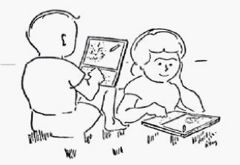Dynabook: Difference between revisions
Jump to navigation
Jump to search
No edit summary |
(added Dynabook image) |
||
| Line 1: | Line 1: | ||
[[Image:Dynabook.jpg|right|thumb|240px|Kay's 1968 sketch for the Dynabook, a Tablet PC for children |
|||
.]] |
|||
The original Dynabook was to be a book-sized electronic slate computer that a child could carry with them. The child would communicate with the slate using an object-oriented programming language and manipulate objects using a pen. [[Alan Kay]] developed this concept while he was working on the [[Smalltalk]] language and later created [[Squeak]] to implement Dynabook concepts on regular PCs. |
The original Dynabook was to be a book-sized electronic slate computer that a child could carry with them. The child would communicate with the slate using an object-oriented programming language and manipulate objects using a pen. [[Alan Kay]] developed this concept while he was working on the [[Smalltalk]] language and later created [[Squeak]] to implement Dynabook concepts on regular PCs. |
||
Revision as of 05:29, 18 October 2007
The original Dynabook was to be a book-sized electronic slate computer that a child could carry with them. The child would communicate with the slate using an object-oriented programming language and manipulate objects using a pen. Alan Kay developed this concept while he was working on the Smalltalk language and later created Squeak to implement Dynabook concepts on regular PCs.
The original description of the Dynabook, "A Personal Computer for Children of All Ages" by Alan C. Kay (In Proceedings of the ACM National Conference, Boston Aug. 1972) is still very much worth reading today.
This book chapter on Personal Dynamic Media shows the Dynabook concept as it existed in 1977.
More in Wikipedia: http://en.wikipedia.org/wiki/Dynabook
